When it comes time to plant tomatoes, it’s easy to become overwhelmed by all your options! Just grab a few seed catalogs, tally the number of tomato varieties available, and you’ll see there are hundreds of different options to choose from.
Heirloom tomatoes offer astounding diversity in color, shape, size, taste, and texture—which I think is part of the fun!
There are small red tomatoes that look average only to make you rethink tomato flavor when you eat them.
And there are the huge yellow and pink tomatoes that can feed a family of four from a single fruit.
And who can forget the striped, bumpy, and downright ugly tomatoes that beg you to try them?
While there are hundreds of heirloom tomato varieties to choose from, I’m going to introduce you to 15 of the best.
What Are Heirloom Tomatoes?
Just like family heirlooms can be passed down from generation to generation, so can heirloom tomato seeds. These are open-pollinated and non-hybrid varieties.
Heirloom varieties are naturally pollinated by means such as insects, the wind, or birds. They also produce seeds that will grow to resemble the parent plant, unless two different varieties of plants cross-pollinate.
One of the things I love about heirloom tomatoes is the diversity present in the fruits. There’s large purple tomatoes perfect for slicing on thick slices of white bread, tart green tomatoes that add a pleasant punch to salads, and meaty red tomatoes that cook down into rich spaghetti sauces.
As far as growth habit goes, most heirloom varieties are indeterminate, which means they grow tall and produce fruits continuously over a few months. However, there are some determinate heirloom tomatoes. Read my article for the difference between determinate and indeterminate tomato varieties.
Since each heirloom is unique, you’ll want to investigate individual varieties before you grow them at home. Consider what size tomatoes you want, whether you like sweet or acidic, and whether you want juicy or firm flesh.
You can use these factors as a starting point to find varieties you may like.
What Is the Difference Between Heirloom and Hybrid Tomatoes?
The main difference between hybrid and heirloom seeds is how genetics are passed between generations.
As mentioned above, if one heirloom tomato flower is fertilized by pollen from a flower of the same variety, the resulting seeds will grow to be identical to the parent plant. When a hybrid flower is pollinated by a hybrid flower of the same type, the resulting seed will grow into plants that are genetically different from the parents.
So while you can save hybrid tomato seeds, they will not produce plants that are true to type (the same as the parent plants).
It’s important to note that while all heirlooms are open-pollinated, not all open-pollinated seeds are heirlooms! Additionally, hybrid seeds are not the same as genetically modified seeds.
Best Heirloom Tomato Varieties
1. Arkansas Traveler

Fruit size: 6–8 ounces
Fruit color: pink
Days to maturity: 80 days
Originating from deep in the Ozark Mountains of Arkansas, this heirloom variety has been passed down for more than 100 years. It was bred and selected to thrive in the often adverse Ozark weather and is known for its ability to remain productive even amidst heat, drought, and heavy rains.
Even when these harsh conditions are present, Arkansas Traveler can produce crack-free tomatoes and remain relatively disease-free.
The plants are indeterminate and produce medium pink fruits throughout the summer. With a flavor that blends sweetness and acidity, the Arkansas Traveler appeals to individuals with diverse tastes.
You can find Arkansas Traveler seeds at Southern Exposure Seed Exchange and TomatoFest.
2. Aunt Ruby’s German Green
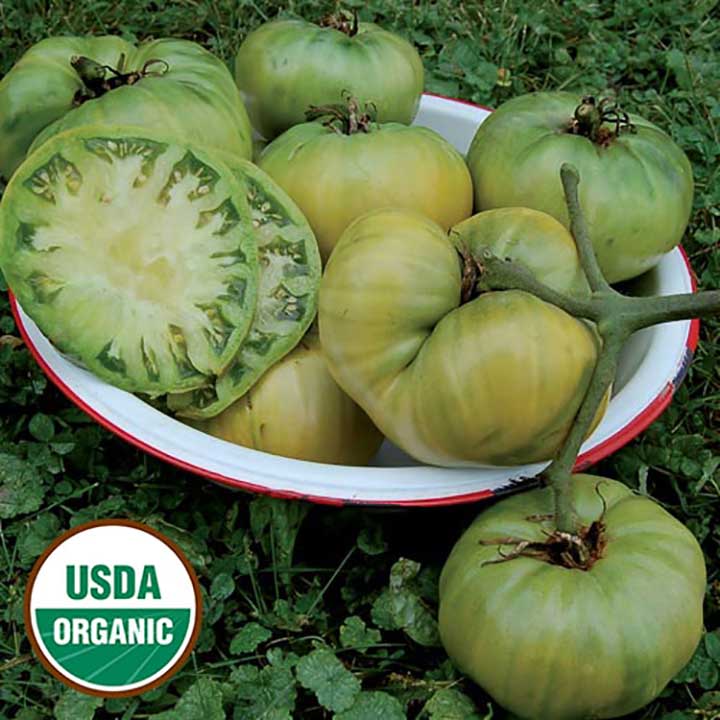
Fruit size: 12-18 ounces
Fruit color: light green
Days to maturity: 80 days
When most people think of green tomatoes, they likely think of unripe crunchy and tart tomatoes that are fried or used in relish. However, Aunt Ruby’s German Green presents another take on the green tomato.
They remain green when ripe and have a sweet and tart flavor with a little bit of background spice. Since the fruits remain green when ripe, it can take a bit of practice to know when to harvest them.
I’ve found that paying attention to the texture of the tomatoes as well as their color can help. Aunt Ruby’s German Green fruits are ripe when the bottom of the fruits have lost their firmness and have a golden tinge—aim to pick them when they are a bit tender but not completely soft.
These tomatoes first emerged from Greenville Tennessee, where they were bred and collected by Ruby Arnold. You can now buy Aunt Ruby’s German Green seeds from Seed Savers Exchange and Fedco Seeds.
3. Black Prince

Fruit size: 3–6 ounces
Fruit color: brownish-red
Days to maturity: 74 days
If you’re looking for a smaller heirloom tomato, the Black Prince is a good choice. The round fruits are typically a bit bigger than golf balls but smaller than baseballs.
When you bite into the fruits, you’ll be met with a rich flavor that’s both acidic and sweet. I also love how juicy the tomatoes are, and think they are a great choice for tomato salads and bruschetta.
The small fruits are more crack resistant than many other types of heirlooms, which makes them a joy to harvest and store. That’s not to say that cracking isn’t possible, but it’s rare that half of the fruits will be split.
This variety is thought to have originated in Irkutsk, Russia which is just north of Mongolia. Therefore, it performs better in cooler areas than many other types of tomatoes.
Look for Black Prince seeds at Johnny’s Selected Seeds and TomatoFest.
4. Brandywine

Fruit size: 12–18 ounces
Fruit color: pink
Days to maturity: 78 days
The Brandywine is one of the best-known heirloom tomatoes—and for good reason. Gardeners around the world delight in the fruit’s large size, bright pink color, and rich tomato taste.
The seed’s appeared in catalogs as early as the 1880s, but it’s not known exactly where they first originated. Many people think the Amish first developed the variety, but others disagree. No matter the case, it was first released to the public by Carolyn Male and Craig LeHoullier.
The plants can get quite tall which means staking or trellising will make growing the plants and harvesting the fruits much more enjoyable. Harvesting the fruits is typically quite easy, due to the tomato’s large size—fruits often reach over one pound!
Traditional Brandywine tomatoes are dark pink in color with bright red flesh. However, you can also find Red Brandywine and Yellow Brandywine.
Look for Brandywine tomato seeds at Johnny’s Selected Seeds and High Mowing Organic Seeds.
5. Carbon

Fruit size: 10–14 ounces
Fruit color: deep purplish-red
Days to maturity: 76 days
Carbon is a black heirloom that delivers the rich flavor these tomatoes are known for. If you’re not familiar with the term ‘black tomato’, note that these fruits are dark purple rather than truly black.
I personally love the supremely interesting and complex flavor that Carbon delivers. One moment they taste sweet and tart, and then they deliver nuanced flavors of smoke and spice—if there’s a tomato that makes you dive into a tasting note manual, it’s Carbon!
Carbon plants are also known for being quite productive, which makes them a more popular choice for commercial growers. The plants also produce medium-large fruits that are big enough to slice for sandwiches but not so overwhelming that one tomato provides three meals.
You can find Carbon tomato seeds at Johnny’s Selected Seeds and TomatoFest.
6. Cherokee Purple

Fruit size: 8–12 ounces
Fruit color: deep purple-red
Days to maturity: 72 days
Although it’s almost impossible to pick a favorite heirloom tomato variety, Cherokee Purple is definitely in my top five. Each summer I await the moment when I can slice into a perfectly ripe Cherokee Purple and make a simple yet delicious tomato sandwich.
When you first look at these tomatoes, you may be tempted to pass by them in favor of more ‘perfect-looking’ fruits. While I think their purple/brown/green color and non-uniform shapes are beautiful, I understand it doesn’t fit into the classic image of a round red tomato—but then again, isn’t that the beauty of heirlooms?
So, what do Cherokee Purple tomatoes taste like? Their flesh is supremely juicy yet firm with a rich flavor that sports sweetness, acidity, and even a hint of smokiness.
The story of the Cherokee Purple tomato is just as appealing. It was introduced to the market in the 1990s by Craig LeHoullier after he received the seeds from John Green of Sevierville, TN whose family first received them from the Cherokee people.
You can buy Cherokee Purple seeds from Southern Exposure Seed Exchange and Johnny’s Selected Seeds.
7. Costoluto Genovese
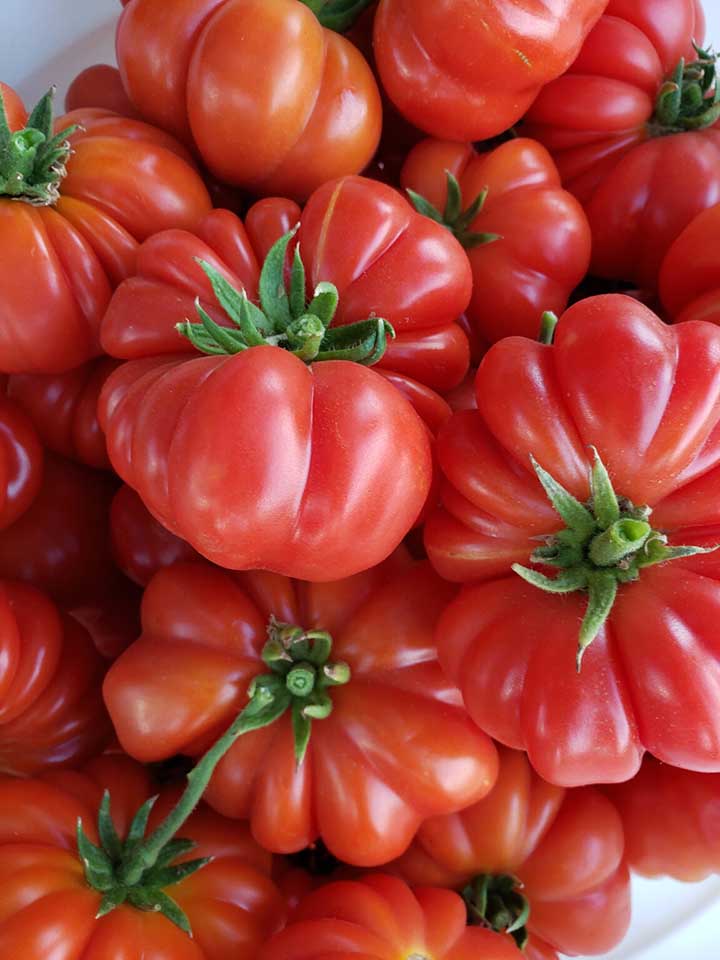
Fruit size: 8–12 ounces
Fruit color: bright red
Days to maturity: 70 days
When you first look at a Costoluto Genovese tomato, you may think people grow it solely for its novel shape. And while the lobed fruits sure are intriguing and fun, these tomatoes also offer a lot when it comes to flavor and texture.
The fruits are popular in Italy where they are prized for their meaty flesh that cooks down well into thick sauces and also holds up well in tomato salads. Although these tomatoes are extremely juicy, they provide a rich tomato flavor that’s a bit on the sweeter side.
I think this is a great heirloom variety to grow due to its versatility. They make sauces and pastes as well as Roma tomatoes, yet they also taste great in salads.
The fruits sometimes curve around their stem, which can make them difficult to pick. I’ve found that cutting the stems is sometimes better than trying to separate the tomato and stem with your hands.
Some seed companies that carry Costoluto Genovese seeds include Wild Boar Farms and Tomato Fest.
8. German Johnson
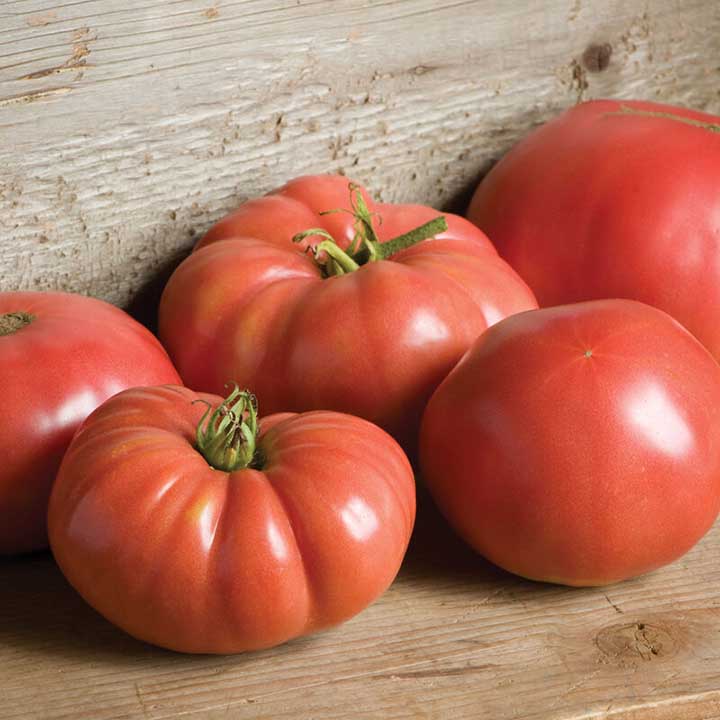
Fruit size: 8–16 ounces
Fruit color: bright pink
Days to maturity: 75 days
If you love the taste and appearance of Brandywine tomatoes but are looking for a bit more productivity, check out the German Johnson.
These plants produce large pink fruits with rich sweet flavor and juicy yet firm and creamy interiors. Simply put, they’re delicious.
Despite its name, this tomato did not originate in Germany. Rather, it is thought to have come from Mennonite farmers who were of German heritage.
The plants themselves are quite vigorous and flourish in the heat and humidity of the South. However, they can be grown successfully throughout the country, as long as you plant them early enough.
Look for German Johnson tomato seeds at Johnny’s Selected Seeds and Southern Exposure Seed Exchange.
9. Green Zebra

Fruit size: 3–5 ounces
Fruit color: bright yellow with light green stripes
Days to maturity: 72 days
While yellow tomatoes are known for being supremely sweet and just a lil’ bit tart, Green Zebra tomatoes are known for their tangy taste. I think their green color and acidic flavor mean they blend well with sweeter and more robust red and pink tomatoes.
The fruits are smaller in size which means they’re not the best for slices, but they work well in salads and salsas. And no matter what you add them to, their bright green and yellow skin will shine!
The variety was first developed by plant breeder Tom Wagner of Washington state and first included in his seed catalogs in 1985. It then rose to a bit of fame when Chef Alice Waters used it in her Berkeley restaurant Chez Panisse.
You can find Green Zebra seeds at many locations, including Johnny’s Selected Seeds and TomatoFest.
10. Mortgage Lifter

Fruit size: 20–48 ounces
Fruit color: dark pink
Days to maturity: 79 days
While we can’t promise these tomatoes will rid you of real estate debts, we still think you’ll be impressed by their size. Fruits often average around two pounds, and it’s not unheard of for individual tomatoes to weigh four pounds!
This variety was first developed by M.C. Byles aka Radiator Charlie. He spent years cross-breeding large varieties such as German Johnson and Beefsteak until he was pleased with the plant which is now known as Mortgage Lifter.
Once he released the seeds, the public quickly became enthralled and demand soared. By selling plants for $1 in the 1940s, he was able to pay off his mortgage.
Today, the Mortgage Lifter remains a popular heirloom tomato variety. Not only are the tomatoes massive, but the plants produce large numbers of fruits and have decent disease resistance.
The tomatoes have a balanced and rich taste, few seeds, and a meaty yet juicy texture.
You can purchase Mortgage Lifter at Southern Exposure Seed Exchange and Ohio Heirloom Seeds.
11. Nebraska Wedding

Fruit size: 7–10 ounces
Fruit color: bright and deep orange
Days to maturity: 90 days
Developed in the Midwest, the Nebraska Wedding tomato is known for its large crop of bright orange fruits. The tomatoes pack lots of flavor, and although they’re on the sweeter side they also have enough acidity to create a nice balance.
While the majority of heirloom tomatoes are indeterminate, Nebraska Wedding is determinate. It rarely grows over four feet tall and produces lots of fruit over a few weeks.
This means it could be a great option if you want to grow an heirloom tomato in a pot or don’t have to deal with lots of trellising. Nebraska Wedding plants will thrive with the help of simple metal tomato cages.
You should note that these plants do take longer to mature than many other tomato varieties. That means you should plant them outside as soon as it is warm enough to do so.
You can purchase Nebraska Wedding seeds through Seed Savers Exchange and TomatoFest.
12. Paul Robeson
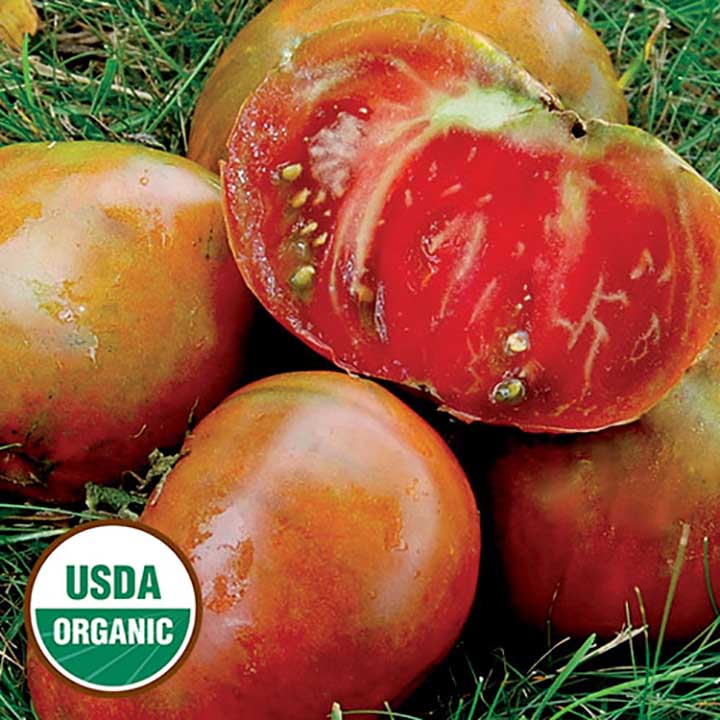
Fruit size: 7–10 ounces
Fruit color: deep red with hints of purple
Days to maturity: 79 days
This variety was developed in Russia and made available more widely by seed saver
Marina Danilenko. It was named in honor of Paul Robeson, an opera singer, actor, athlete, and advocate for Black rights who was popular throughout the world, including Russia.
Paul Robeson tomatoes are considered black tomatoes, with dark red fruits that sport purple undertones and green shoulders. They have a complex and rich flavor with a bit of underlying smokiness.
This variety has surged in popularity in the last ten years due to what some people consider unparalleled flavor. The texture is also a superb blend of meaty and juicy, and the fruits have few seeds.
Numerous seed companies carry Paul Robeson tomatoes, including Southern Exposure Seed Exchange and Seed Savers Exchange.
13. Pink Oxheart
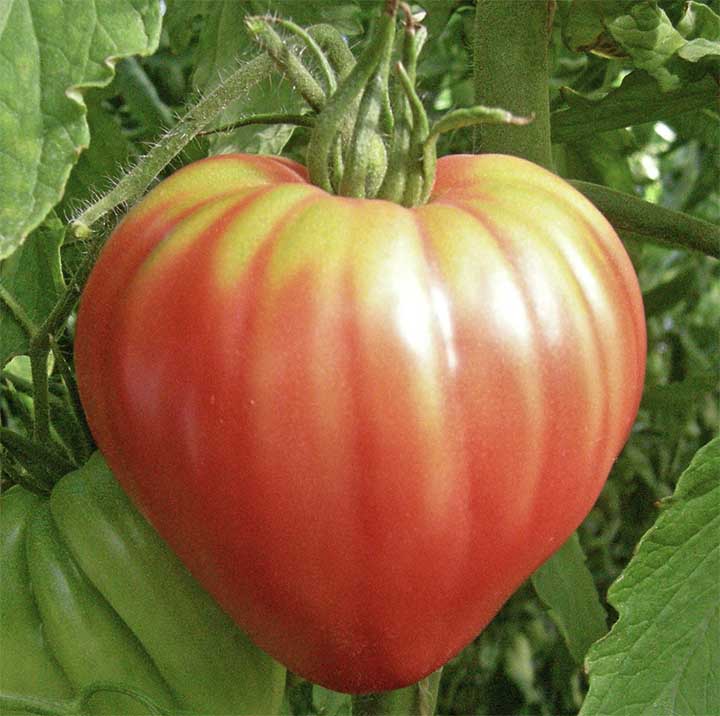
Fruit size: 16–32 ounces
Fruit color: bright pink with yellow-green shoulders
Days to maturity: 80 days
Oxheart tomatoes are known for their heart-shaped fruits, and the Pink Oxheart is no exception. These heirloom tomatoes were first developed in the 1920s and although they aren’t super common, they remain beloved by those who know them.
While their shape may be a bit different, the tomatoes’ taste is remarkable and definitely that of a tomato. Its flavor somehow combines supreme sweetness with bright pops of acidity and satisfying richness.
Both the Pink Oxheart’s skin and its flesh are bright pink, hence its name. Although the tomatoes are heart-shaped, they are large enough to slice for sandwiches.
These plants are indeterminate, and their vigorous vines benefit from staking and/or trellising.
You can purchase Pink Oxheart seeds from Eden Brothers and Ohio Heirloom Seeds.
14. Striped German

Fruit size: 12–20 ounces
Fruit color: yellow with red shading
Days to maturity: 78 days
Talk about a beautiful tomato! The Striped German stands out with bright yellow skin that’s streaked and splashed with deep red. And when you slice into one of these tomatoes, you’ll be equally enamored by its marbled flesh.
Striped Germans tomatoes have a sweet flavor with fruity notes and less acidity than many other varieties. The flesh is firm yet juicy which makes it appropriate for sauces, salads, and sandwiches.
I love Striped German tomatoes due to the few seeds they produce and the lack of dense core present in other larger tomatoes.
The plants are heavy producers and will easily give you over ten pounds of tomatoes throughout the course of the summer.
Look for Striped German seeds at Johnny’s Selected Seeds and TomatoFest.
15. Speckled Roman
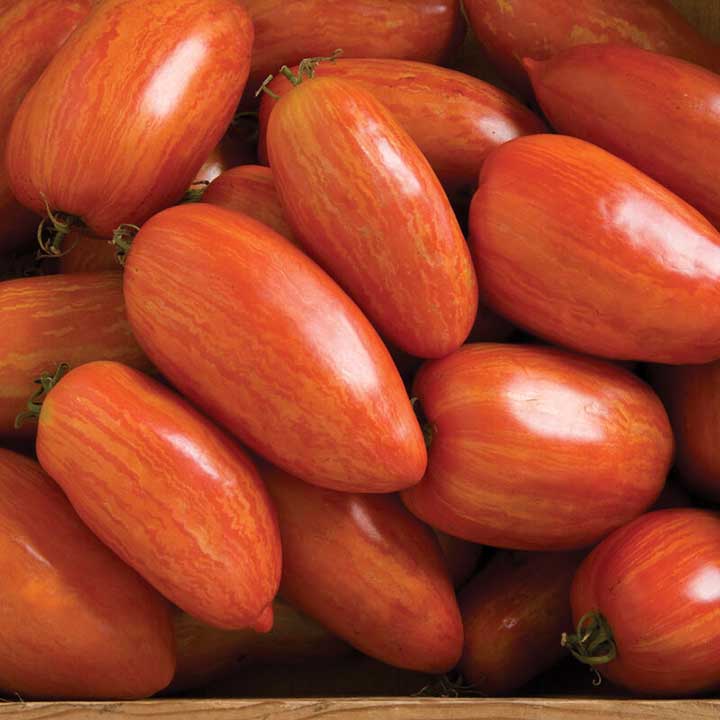
Fruit size: 12–20 ounces
Fruit color: bright red with dark yellow stripes
Days to maturity: 85 days
Roma-type tomatoes are known for their meaty flesh, lack of seeds, and ability to make delicious sauces and pastes. However, their flavor is sometimes a bit lackluster.
The Speckled Roman, also known as Striped Roman, offers a texture that’s great for canning along with a bright flavor that tastes like a classic tomato but amplified. I’ve grown Speckled Roman tomatoes for many years and used them to make sauces and salsas to can or freeze for the winter.
Along with being delicious, the Speckled Roman is a great producer. You can expect to harvest handfuls of tomatoes each week over the course of a few months.
This variety was first developed by Seed Savers Exchange member John Swenson after he crossed Antique Roman and Banana Legs. Speckled Roman first hit the market in 1999.
You can purchase Speckled Roman seeds through the Seed Savers Exchange and Totally Tomatoes.
Check out our ultimate guide on growing tomato plants here.






